Are You A Vanguard? Applications Now Open
This is your first of three free stories this month. Become a free or sustaining member to read unlimited articles, webinars and ebooks.
Become A MemberOn a cool, cloudy evening last June, several dozen people, many of them carrying a mini cooler or a folding beach chair, gathered for a free concert in a small park about a mile inland from the Atlantic Ocean, in Asbury Park, New Jersey, the city where Bruce Springsteen launched his career. Men and women wearing khaki shorts, sensible footwear and rich, even tans drank from plastic cups, dipping in and out of loose conversational circles in the improvised choreography of backyard barbecues. From a low stage, speakers played a warm-up soundtrack of ’90s college radio rock: Dave Matthews, Alanis Morissette, Pearl Jam. The mix wasn’t out of step with the crowd, which was largely white and middle-aged, with intermittent clusters of loose-limbed 20-something surfers and substantially paler, scruffier young men sporting clunky sneakers and cargo pockets. For the occasion, though, it seemed something of an odd choice.
Springwood Park had opened nine days earlier, just west of Asbury’s railroad tracks, at the corner of Springwood and Atkins avenues. The tracks, part of a route that brings shore-dwelling commuters north to New York City and urban weekenders south to Jersey beaches, roughly bisect the city. They have long represented a meaningful racial divide. For a good part of the 20th century, Springwood Avenue was a hub for black musical culture. Jazz clubs, bars and hotels lined its blocks. Artists like Duke Ellington, Count Basie and Ella Fitzgerald regularly performed there. But in 1970, racial tensions gave rise to rioting on the West Side, an outburst that accelerated white flight from the rest of the city. Fire and looting destroyed or otherwise closed Springwood’s clubs, as well as the dozens of small businesses that had occupied the avenue.
For decades now, the surrounding neighborhood has been poor and overwhelmingly black, starved of services and troubled by occasional surges of gang violence. Asbury Park is a shrimp of a city: 16,000 residents on roughly 1.4 square miles. The West Side’s isolation is made more pronounced by its close proximity to more prosperous neighborhoods. Cruise Main Street, which runs along the railroad tracks, and you will find that destination arrows invariably urge you east, along broad tree-lined avenues past stately Victorians — toward the sea and the merchants who make their living being near it. Seekers of lodging or leisure have few (if any) reasons to head west. Springwood is the first and only public park ever built west of the tracks, and it had been long in coming, its construction mysteriously delayed since 2009. But among some West Siders, there was cautious optimism that the concert in June — the first in a weekly series scheduled for this summer — might be a sign that the city was trying, finally, to bring them into the fold.
Since the park’s opening, it had attracted frequent picnickers, and players of chess and checkers from the neighborhood. “I take my [three] kids there every day,” one father in his late 20s, who has spent the bulk of his life on the West Side, told me. “I work out there myself.” When I asked whether he thought Springwood Park had changed the mood in the community, he hesitated. “You can see the hopes in people’s faces,” he said finally. “But don’t get me wrong. They’re not too overly excited. They’re so used to things starting to happen and then stopping.”
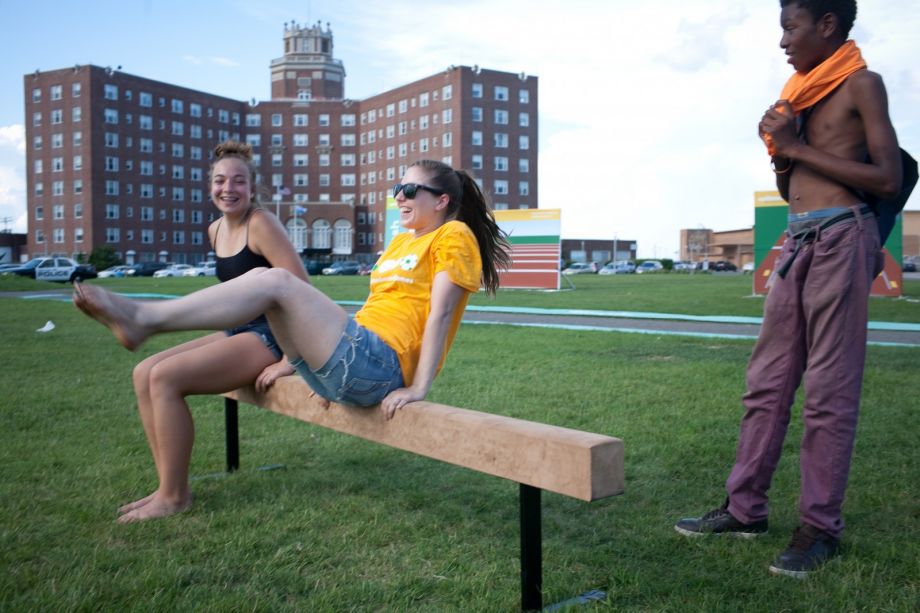
Teenagers hang out at a park not far from the boardwalk.
To be fair, things on the east side had not, for many years, proceeded all that smoothly either. At the height of its popularity, in the early 1900s, Asbury was among the country’s premier middle-class destinations. It had 200 hotels, 11,000 rooms among them. But in the decades after World War II, many were torn down for want of guests, while others were converted to house patients discharged from psychiatric facilities. Incompetence, graft and inclement economic weather meanwhile waylaid a succession of redevelopment initiatives, including plans to import the Ringling Bros. circus and something called a Jacques Cousteau Wonder World. Many of the city’s Victorians moldered — neglected, abandoned or subdivided into low-rent rooming houses. By the early 2000s, commerce had slowed nearly to a halt. The boardwalk stood empty and begrimed even in summer, its concessions stands dark.
And then, gradually, things began to change. In 2009, iStar Financial, a New York-based real estate investment firm, took control of the city’s waterfront redevelopment. Since then, iStar has opened two high-end condo complexes, plus the Asbury, the city’s first new hotel in more than 50 years. Korean tacos, ceviche and locally roasted coffee now emerge from the windows of refurbished boardwalk stands. Modish crowds have appeared to patronize the art-house movie theater and bookstore on Cookman Avenue, a long-dormant commercial artery that has lately become a locus of bars and restaurants. Farther inland, buyers priced out of the Hamptons have restored the old Victorians, a practice begun in the ’90s by the gay community. (When locals say “West Side,” they really mean the area west of the tracks and south of Asbury Avenue, which splits the city latitudinally; rich in historic homes, the northwest section of the city was among the first targeted by the fixer-upper set.) Real estate values have climbed. The city’s need for state aid has waned. On the street, the odd Tesla can be seen nosing past more numerous Mercedes and BMWs.
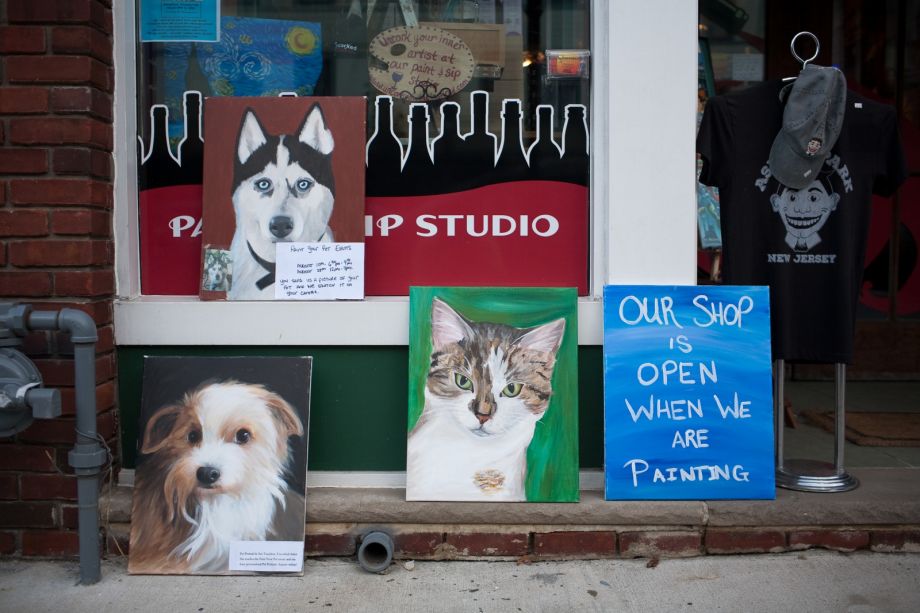
Many bars, restaurants and shops have recently opened on Cookman Avenue.
It’s all been rather unexpected. And in a strange way, the city’s renaissance has relied as much on what previous planners had failed to accomplish — on the mega-complexes that went unrealized, the urban renewal initiatives left incomplete, the circus that never came to town — as on what iStar and others are bringing to life. Bret Morgan, an entrepreneur who opened his first business in Asbury in 2008, told me of his early days there, “You could see the opportunity. Practically everywhere on the shore, real estate costs millions, and here you had abandoned buildings right on the boardwalk.” No mall or casino marred the coastline, as they do in other hard-luck beach towns of yore, like Coney Island and Atlantic City. Asbury’s stock of detached single-family homes remained largely intact. The greedy ineptitude of developers and elected officials had caused the city to degenerate into a kind of urban loam. Morgan continued, “We looked at it almost like an entrepreneur’s playground.”
Back at Springwood Park, someone killed the intro music and the evening’s headliner, Gedeon Luke & The People, appeared. Luke, a black man from Memphis, was lithe and exuberant, an evangelist-frontman in a bright patterned vest and matching headscarf. A number of black families had filtered in during the warm-up and gathered near the front of the crowd. Luke bounded from the stage and pogoed there, clapping a tambourine over his head. As his band went into Sly and the Family Stone’s “Dance to the Music,” a hype man circulated, bouncing babies, giving high fives, and exhorting audience members to heed the lyrics’ instructions. On the playground, perhaps two dozen black children clambered, joyfully uninterested in the live entertainment. The People put horns, wah-wah pedal and keyboard to liberal use in a series of funky, soulful covers. Themes of healing and mercy figured prominently. Between songs, Luke held forth on love, hope and togetherness. As the night darkened, a breeze picked up and rain began to fall.
In the early 2000s, Paul McEvily, an associate executive director at Interfaith Neighbors, a nonprofit based in Asbury Park, was working on a West Side revitalization plan. For guidance, McEvily met with Hazel Samuels, who was then Asbury’s director of housing and community development. Samuels was a leader in one of the West Side’s numerous churches. She had worked in local government for some 30 years. McEvily hoped that she could connect him with other West Side leaders, who might educate him about the neighborhood’s needs. But Samuels looked dismayed. “Please tell me you’re not going into that community again to ask what they need,” she said. “What you need to do is go to the shelf.”
Samuels showed McEvily a cache of previous West Side revitalization plans, authored over the last three decades by other well-meaning souls. There were 17 of them. None had been implemented. “They were amazingly consistent,” McEvily said recently. “People were always asking for the same things: ‘We need jobs, housing, working infrastructure, something for the kids to do, and please, keep us safe.’”
In 2006, Interfaith Neighbors’ plan for the West Side, which included roughly 60 possible projects to be completed over 10 years, was approved by the New Jersey Department of Community Affairs. DCA approval made the plan eligible for a program offering a state tax credit to businesses investing in low- and moderate-income neighborhoods. With help from diverse funding sources, Interfaith’s first large-scale project on the West Side, the $7 million Springwood Center, was completed in 2012. On its upper levels, it features eight low-to-moderate-income apartments and a senior center. Below, the Kula Cafe serves casual fare — often prepared with food grown nearby by the associated Kula Farm — while providing job training to West Side residents. Interfaith also runs a business development center out of the facility, offering mentoring and office space to early-stage ventures. Its greatest importance, however, may be symbolic: Springwood Center, which stands across the street from Springwood Park, represents the only new commercial space built on Springwood Avenue since the 1970 riots.

Paul McEvily, of Interfaith Neighbors, walks through Kula Farm.
One day last June, I met McEvily at Interfaith’s headquarters, a short brick building shaded by a tall tree on a slightly scruffy block immediately east of the tracks. We spoke upstairs in a small conference room, where large photos of four-bedroom homes were displayed. Each had recently been built or refurbished by Interfaith and sold to a family in need of affordable housing, in sync with a citywide blight-removal initiative. McEvily is a slender man with light eyes and neatly parted gray hair. He wore a sky-blue polo, khakis and a reddish tan that suggested a standing weekly appointment for golf or tennis. A 23-year veteran of the Federal Reserve Bank of New York, McEvily talks fast, with an easy fluency in the Byzantine workings of public-private finance.
From a fat stack of documents, McEvily selected a large overhead photograph of the Springwood Avenue Redevelopment Area, a zone whose boundaries were first defined by the city in 2004, and updated in 2014. The image showed many lots with the mottled sandy-olive complexion of desert camouflage, vacancies representing virtually all of what had once been the busy Springwood Avenue commercial district. The photo had been highlighted, supplied with an alphanumeric key indicating the purpose — retail, residential, mixed-use — and the developer that had been assigned to each lot.
McEvily pointed to two locations on which Interfaith had received approval to build. One, a large parcel across the street from the tracks, is slated for a multipurpose center containing performance and programming space, and a restaurant in the tradition of Springwood Avenue’s jazz clubs. (The owner/operator for the latter remains undetermined.) It lies within the redevelopment area’s Gateway Zone, which will aim to attract visitors to the West Side as they arrive in town. The other parcel is catty-corner from the Springwood Center. When final rounds of permitting and paperwork are complete, Interfaith plans to begin construction there on the Turf Club Residences, a townhouse-style project containing both affordable and market-rate condos. (A provision in the redevelopment area requires that at least 20 percent of all new residential construction is affordable.) Directly behind the Turf Club site stands a low-rise public housing development, which, McEvily acknowledged, some market-rate investors might find off-putting. “It’s going to have to be a buyer who recognizes that they’re getting in relatively early in a redevelopment area,” he says.
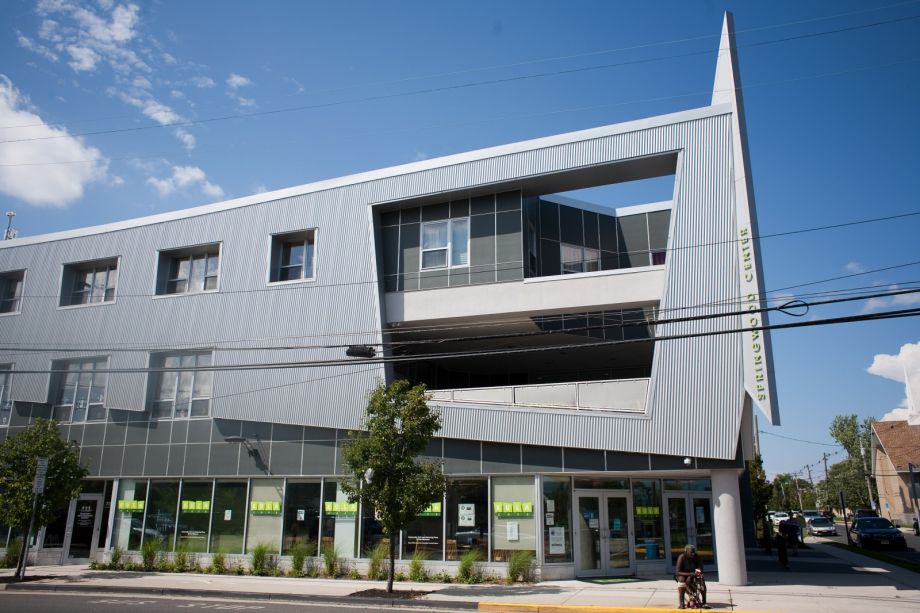
Springwood Center was the first and remains the only new commercial development built on Springwood Avenue since riots in the 1970s.
He found cause for optimism, though, in 603 Lake Avenue, an expensive market-rate building several blocks away — outside the redevelopment area, on the east side of town, with views of picturesque Wesley Lake — which opened earlier this year and has all but sold out. McEvily was less sanguine about a trio of residential sites on Springwood Avenue, on which Interfaith had hoped to build, but which went instead to The Michaels Organization, a for-profit builder of affordable housing. Michaels enjoys a strong national reputation. But their plan to build exclusively below-market-rate rentals won’t increase West Siders’ ownership stake in the community, nor is it likely to foster the sort of economic and racial diversity on which the neighborhood’s future depends.
“There are some who would say that it was a giveaway on the part of the [city] council,” McEvily said of the agreement with The Michaels Organization. Mayor John Moor, for one, voted against it. “The expectation was to have mixed-income buildings, with some owner-occupied units,” McEvily continued. “What [Michaels] propose to do is not what was envisioned in the plan.” The developer initially suggested that they might break ground by late summer 2015, but the project remained on hold, pending financing, until recently. In late July, the city announced that $7.87 million had been allocated to the Michaels development, which is known as Renaissance Village, through the state’s Fund for Restoration of Multifamily Housing. Work on Renaissance Village is expected to begin this year.
On the morning after the concert in Springwood Park, I walked to a Perkins restaurant just outside the city, to meet with representatives of the Asbury Park-Neptune Minister’s Alliance, an organization of about a dozen pastors representing various local congregations. (Neptune is a town bordering the West Side.) The Alliance has a reputation for intense suspicion — if not outright hostility — toward all things redevelopment-related. These days, many habitués of the east side evince a localist enthusiasm reminiscent of the mood in Boston during the 2004 pennant race — the fanaticism of a perennial underdog, suddenly vindicated — and I was interested to hear some countervailing perspectives.
At the restaurant, the Rev. Sandra Gonzalez, a spiffily dressed middle-aged woman with dyed-blond hair and a striped silk scarf, was seated over coffee with the Rev. Edmond Lee and the Rev. John Bradley. Gonzalez, Lee and Bradley are all black. Together, they compose the Alliance’s executive board, with Bradley as president. For more than 50 years, the Alliance has acted as liaison between Asbury’s and Neptune’s most underserved communities of color, and school boards, police departments, city councils and the like. During that period, countless promises have been made and broken. It was difficult to find an area of public life in which the ministers didn’t take a dim view of current events. Underlying most all of their concerns lurked a sense of disconnection. They held an unshakeable belief that even things ostensibly undertaken on behalf of West Siders were not in fact being done with their interests and perspective in mind.
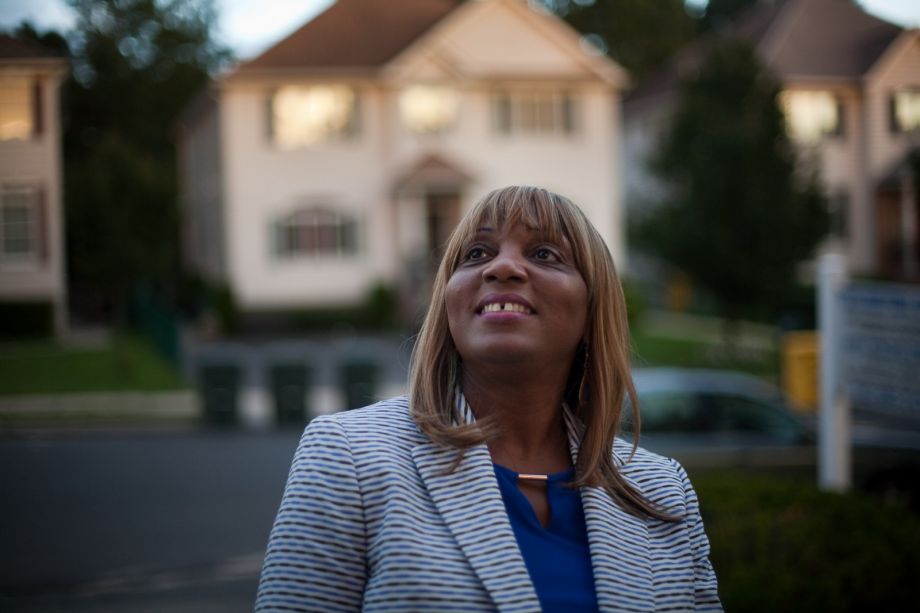
Rev. Sandra Gonzalez is on the executive board of the Asbury Park-Neptune Minister's Alliance, an organization of about a dozen pastors representing various local congregations.
“Most people in the immediate area don’t have no idea of what the plan is really all about,” Bradley, an older man with a gentle manner and a low, slow Georgia drawl, said of the city’s West Side redevelopment plan. He considers that when the plan was updated, in 2014, the community wasn’t sufficiently involved: “What we want is someone to come out and communicate the modifications. Why are there deviations from the original plan? Why was not the community involved in that chain of redevelopment?”
The 67-page Amended Springwood Avenue Redevelopment Plan lists a 17-member advisory committee, including the Rev. Kevin Nunn, who was at the time vice president of the Alliance, and the Rev. David Parreott, another West Side minister. Still, Lee noted, delays in construction — of the park, of residential buildings — give people pause. For locals used to being disappointed by developers and administrators — and mostly unfamiliar with the hold-ups characteristic of even ultimately successful political and real estate deals — the abiding emptiness of Springwood Avenue looks ominous. “When you have something outstanding so long … ,” Bradley trailed off.
The ministers object, too, to what they regard as the timid bargaining tactics of public officials. “The city says they can’t force developers to hire local people,” Bradley said. “We think differently. They say, ‘Our hands are tied.’ I don’t buy that.” Bradley and Lee enumerated the things they see lacking from their neighborhoods: laundromats, grocery stores, stable affordable housing, good public transportation, fitness facilities, cultural attractions, professional training services, activities for young people, aggressive pursuit of predatory landlords, police responsive to and unafraid of the people they’re policing. That Asbury’s murder rate had fallen recently, they said, didn’t mean the conditions that breed gang activity had been meaningfully addressed.
Paul McEvily is aware of the Alliance’s grievances. Quite a few of the items the ministers identified, however, are provided for, either specifically or in general terms, by the city’s revitalization plan. McEvily worries that West Siders’ conflicted feelings about development might prevent them from participating, depriving them of proprietary positions in new enterprises. “If you want persons of color to be owners of those storefronts when bricks and mortar come out of the ground, you need to act now,” he told me. To that end, he engaged Daniel Harris, a deacon at the Second Baptist Church, to survey residents for opportunities to bring what McEvily calls “kitchen tabletop businesses” — an informal economy of chefs, jewelers and clothing makers operating from their homes — onto Springwood Avenue. But when I spoke to Harris by phone, it seemed that his results so far mainly consisted of requests for services, often the same ones described by the Alliance ministers.
Harris, who is in his late 60s, has lived in Asbury Park or just outside it practically all his life. His memory is long, his sense of injustice rich. He mentioned that Boston Way, a high-rise West Side housing project, was still standing. Once a locus of crime, in 2014, Boston Way was emptied and boarded up, pending redevelopment. Its former occupants received Section 8 vouchers for relocation; Harris says most left the area. Today, the vacant complex is forbidding. Harris sees its evacuation as part of a plan to disenfranchise black voters. “It’s just sitting there,” he said. “They say they don’t have the money [to demolish it.] From a political point of view, they took those votes out of the city.” (Since 2013, voter suppression in Asbury Park has been the subject of an investigation by the county prosecutor, and a separate lawsuit.) I asked if history made it difficult to believe that the city would pursue the neighborhood’s best interests. “Yes,” Harris said. “How many times can you do me dirty, and then say, ‘Let’s try this again’?”
Some weeks after Harris and I spoke, the city announced that $12.35 million in state funds had been allocated to redevelop Boston Way. Officials have indicated that work on the project, which will be made up of mixed-income affordable housing, including Section 8 homes, will start this year. But Harris remains cautious. “I’m somewhat more optimistic,” he said when I called him again after the announcement. “My question is, will the people from the existing neighborhood be accepted there, and will the people who left be able to return? You try to be happy. But pessimistically happy.”
In 1998, Ed Johnson and his partner, Jeff Lundenberger, bought a house in the northwest section of Asbury Park. Johnson, who grew up in South Jersey, could remember cutting school as a teenager to visit the city with friends. Each time they came, it seemed, something else had closed — a ride, a boardwalk game, a restaurant. By 1994, when Johnson and Lundenberger visited for the New Jersey Pride festival, Asbury had become ghostly. But the couple, who lived in Jersey City and worked in Manhattan, admired its grit. They felt drawn to a certain indefinable pulse about the place. Soon after buying the house, they invited friends to come for the Fourth of July. When the group went to the boardwalk for fireworks, though, a police officer advised them that there would be none. Johnson attended the next meeting of city council to find out why. One council member explained that he and his colleagues had assumed residents would prefer to spend the holiday in a “better community.”
Johnson was flabbergasted. How could elected officials be content to rely on services provided by neighboring towns? (Two of those officials were subsequently jailed for corruption.) Johnson became a regular gadfly at council meetings. He got himself appointed to the board of the Urban Enterprise Zone and, in 2004, to city council. From 2009 until 2013, Johnson served as mayor. His tenure represents arguably the most transformative period in Asbury Park’s history. But before the city could move forward, it had to attend to what he calls “non-sexy” work: clearing decades’ worth of detritus, replacing the city’s decayed innards. New streetlights relieved a hostile-seeming gloom. Police cruisers got fresh tires and seats. New asphalt and plumbing went in. “The stuff we found under the street — it was like Jurassic Park,” Johnson told me. “We found cash registers from the 1930s, parts of cars from the 1940s.”
He estimates that the city spent $15 million on infrastructure upgrades, much of it on the West Side. He can seem impatient with neighborhood advocates unwilling to relinquish grudges that appear to him obsolete. “All my career, people got up at the microphone and said, ‘You’re not doing anything for the West Side!’” Johnson said. “They’d say, ‘Look at the beachfront!’ But almost everything done on the beachfront was done with a private developer’s money. Everything on the West Side was done with public money that we made from the beach side.” He likened the animus to persistent anti-Russian sentiment in the U.S. after the collapse of the Soviet Union. “They’re making a generational argument that simply does not hold up to the facts. I’m not saying that everything is cured. But 2017 will be better than 2012, which was better than 2010.”
Around Asbury Park’s new entrepreneurs and homeowners, there hovers a kind of buzz — an energy such as one might have felt 10 or 15 years ago at farmers markets in certain neighborhoods of Brooklyn. Its precise components are difficult to pinpoint. But the recipe looks something like this: one part moral satisfaction, two parts giddiness at getting in near the ground floor. And yet — perhaps owing in part to an ongoing and increasingly loud national conversation about gentrification — the left-leaning commitment to social justice that often feels merely cosmetic in Park Slope seems, among Asbury Parkers, sincere. In April, Salt Hotels, the company that operates the Asbury, graduated 110 students from a 10-week hospitality training program that the company provided free. A majority of students were from Asbury Park and Neptune, and the Asbury hired more than half of them. But it was simply a macro version of what many small business owners were already doing.
The Kula Cafe at Springwood Center operates with the guidance of Marilyn Schlossbach, the owner of five area restaurants. Kula Farm has several restaurant partners, some of which buy whatever happens to be growing there. One is Russell Lewis, the owner of Watermark, a sleek boardwalk cocktail lounge. Lewis also has fundraising relationships with the Musical Heritage Foundation, which helps to produce the Springwood Park summer concert series, and other groups. Kula Farm runs a post-incarceration work program, which shepherds alumni into the local economy. There is, John McGillion — the owner of a popular Main Street bar — told me, an “esprit de corps,” a feeling of collective obligation to remediate entrenched problems. At Second Life Bikes, Kerri Martin, the owner, teaches children to restore bicycles, imparting life skills in the process. She has given a TED talk on the subject. Cowerks, a co-working space co-owned by Bret Morgan that caters to Asbury’s growing population of youngish freelancers, gives free coding classes through a local school. Everyone knows everyone. Efforts mesh, often intersecting with nonprofits like the Boys and Girls Club, Interfaith Neighbors and Covenant House.
The Kumbaya quality described here does not mean that everyone hopes for utopia. “There are various programs, yes,” Russell Lewis told me. “The issue is that there are very few people interested. It’s not like there are a bunch of kids from the West Side beating our doors down, looking for work. It’s very hard to get these kids motivated and to take initiative, and to find the ones that are really looking to learn skills.” He continued, “I want the property values to go up. I know that’s not something that a lot of people here are willing to admit, because we all know what that means.”
West Siders who have benefited from the support of local businesses and nonprofits are not insensible of such perceptions. Darryl Bunting, who is 27, grew up in a rough corner of the West Side. Before he reached his teenage years, he began stealing bikes on the boardwalk; later, he graduated to drug sales and robbery. In 2009, he was released from jail as a twice-convicted felon. He found steady work hard to get. Through a friend, he connected with Interfaith Neighbors. They put him on as a construction worker at Springwood Center. In his youth, Bunting had done odd jobs at his grandfather’s construction sites. From ground breaking until the last brick was laid at Springwood Center, he oversaw a team of laborers. Today, he lives in an apartment there.
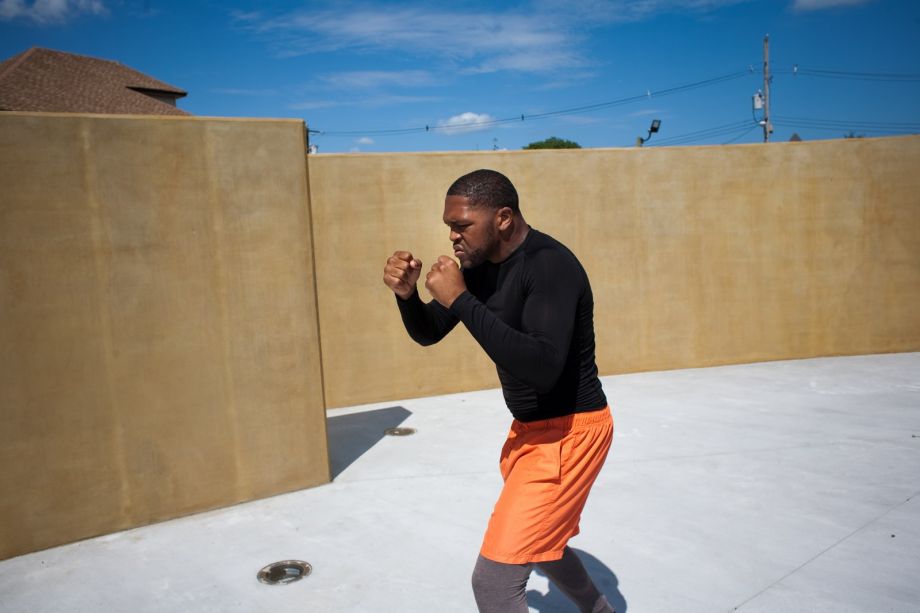
Darryl Bunting does his daily workout in Springwood Park.
“I see a lot of people — they’re always so quick to jump out and judge the urban community,” Bunting told me. “But if they would just get out and show these kids that there’s another way of life — a different way to think.” With the help of a job at Interfaith’s meal-preparation service, which accommodated his training schedule, Bunting has become a professional boxer; he has shared his story with young men — some of them disposed, perhaps, toward mischief — at Covenant House. “It was that support,” Bunting said of his relationship with Interfaith. “You’re so used to getting let down — by your parents, aunts, friends, uncles, job offers telling you they’re going to call back, but they don’t because you have a record. With the support that they gave me, they conditioned me to believe in myself.”
In training sessions for the young West Siders who staff the Kula Cafe, Marilyn Schlossbach emphasizes hands-on front-of-house skills — bussing, serving, taking orders — but also less tangible competencies, like self-confidence and interpersonal pizzazz, which she hopes will ready employees for opportunities in the wider world. “How do we get these kids to feel self-worth?” Schlossbach said, describing her motivation for starting the cafe. “How do we give them the confidence to be able to go out there and talk to people, to go and get that job — these little skills that we take for granted?”
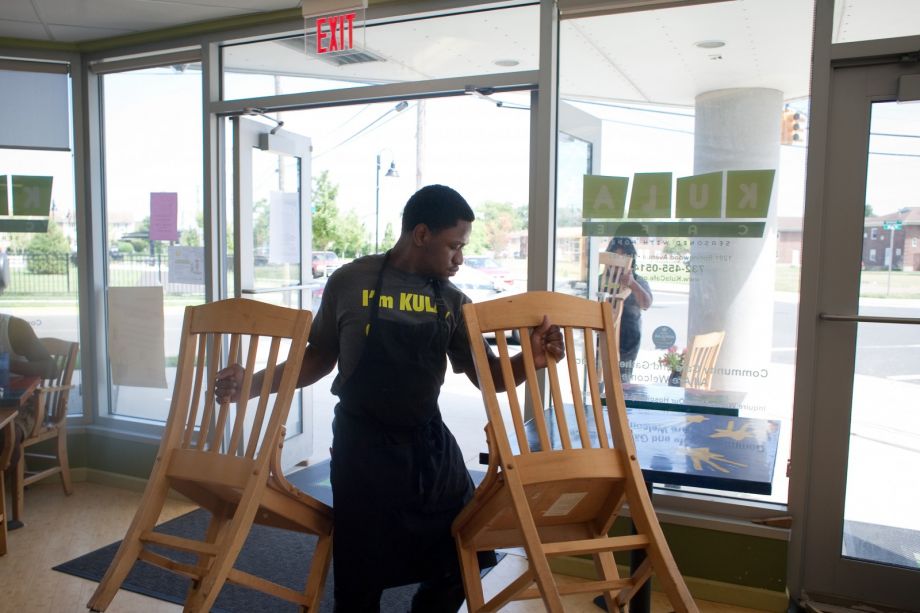
Kula Cafe teaches its employees interpersonal skills to prepare them for future job opportunities.
Davon Byers, who is 19, began working at Kula about four months ago, following in the footsteps of an older brother, who worked there in the past. “They helped me out a lot mentally, and they also helped me with my speech,” Byers told me. Previously, he’d held jobs at a warehouse, at a farm stand and at Sky Zone, a trampoline park. “Other places, they just get straight to the point: Do your job. Here, I have to learn a lot about the restaurant business. And they taught me how to talk to people — how to deal with confrontation.” Khaila Johnson, who is also 19, started at Kula last November — also continuing a family tradition, started by her older sister. It is her first job. Having accumulated some months of experience, she said, she now particularly enjoys imparting what she’s learned to new hires.
Byers hopes one day to own his own restaurant; Johnson plans to become a veterinarian. Both noted a lack of activities on the West Side for people their age. “We can go to a park, but we’re not really going to enjoy ourselves there, because it’s for kids,” Byers said. “I feel like us older people, we need something too — a better recreation center, basketball courts — activities to keep us busy so that we’re not on the street, or bored to where we have to go to the street.” Johnson, for her part, would like to see more cultural offerings — particularly foreign language programs.
But despite the city’s abiding deficiencies, given Asbury’s scale, it is possible to be hopeful about the cumulative potential of small individual actions. Surveying the city on foot, one feels a disorienting sense of compression. The scenery seems to change too quickly — from beachfront resort to hushed suburb, from high-end commercial low-rise to shabby public housing. Even by the standards of American cities, its juxtapositions are stark.
Until the early 20th century, the West Side wasn’t part of Asbury at all. It made up what Daniel Wolff, author of 4th of July, Asbury Park, has called a “shadow city,” a district of makeshift dwellings, without paved streets, a sewage system or garbage pickup. The neighborhood housed workers for the city’s public maintenance crews and shorefront shops and hotels, many of them recent immigrants or African-Americans from the south. Over the objections of James A. Bradley, who founded the city in 1871 — and who feared that property values would suffer with the addition of black citizens — Asbury annexed the West Side, in 1906, in a ploy to increase tax revenue.
Bradley’s biography reads like a fable of his era. He grew up on New York’s Lower East Side, the son of an English mother and an alcoholic Irish father who died when his son was 5. In youth, he had, in his own phrase, “a fondness for wine.” He joined the notorious downtown gang the Bowery Boys, and later apprenticed himself to a brush manufacturer. Soon thereafter he became a devout Methodist. By 40, Bradley had grown rich running a brush factory of his own. In later years, he would eschew Asbury beaches in favor of long European vacations. His city, named for Bishop Francis Asbury, always had for him a primarily religious purpose: to maintain wholesomeness among pleasure-seekers. It also buffered the strict Methodist cloister of Ocean Grove from the sins of Long Branch, a raucous town to the north. In part, Asbury Park was conceived, quite literally, as a line in the sand.
In his Atlantic City history Boardwalk of Dreams, historian Bryant Simon emphasizes the extent to which that town’s pre-casino heyday — about the same as Asbury’s — relied on segregation for its most important commodity, which was to give middle-class vacationers a temporary sense of glamor and superiority. No attraction better typified that product than the city’s rolling chairs. White tourists would dress up and pay a small fee to black men who pushed them up and down the boardwalk in small wicker chariots.
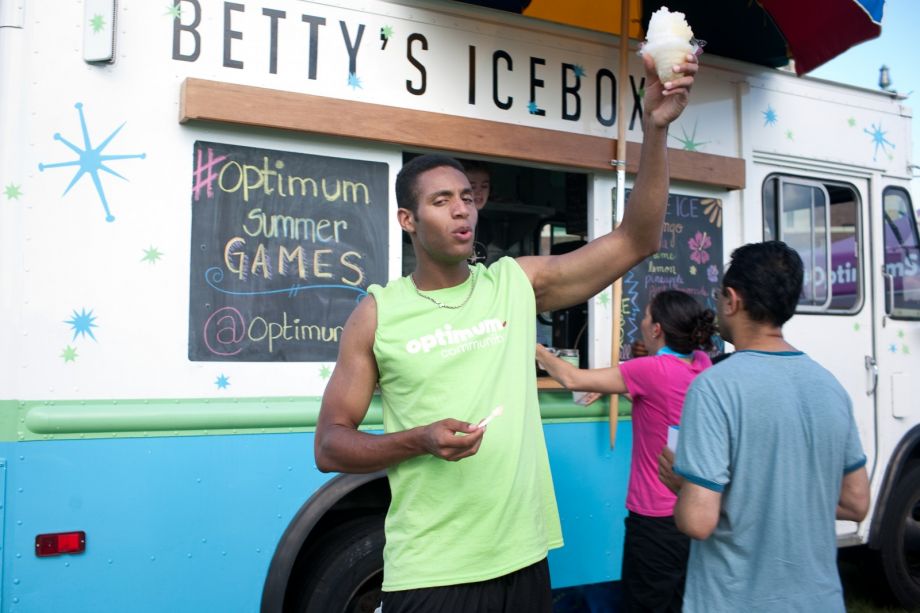
Boardwalk visitors stop by an ice cream truck.
Asbury Park had rolling chairs, too. A friendly port to the Ku Klux Klan in the ’20s, its beaches remained de facto segregated into the ’70s. But when legalized gambling arrived in Atlantic City, in 1978, it didn’t come to Asbury Park, a great disappointment to then-mayor Ray Kramer. In Simon’s view, at bottom, casinos offered more or less what the rolling chairs had: a kind of masquerade of privilege, the illusion of sudden social mobility. Absent a life-changing jackpot, you could still stroll gilded halls, cigar in hand, with servants in reach. Ensconced in fortress-like gambling halls, tourists and their dollars rarely came into contact with the poor, largely black residents who lived in the housing projects on the west side of town. If the casinos had not come, Atlantic City would have left open the possibility of following Asbury Park’s trajectory, for good or ill. Its neighborhoods might have eventually regenerated at a speed and scale commensurate with more lasting stability. Instead, Atlantic City tried to remake the past, a strategy it has since reprised, with minor variations, to disastrous effect.
Were it not for the number of rainbow flags that hang from the front-entry flagpoles attached to many Asbury Park homes, a good portion of town today would look downright Rockwellian: kempt green lawns and picket fences; wide, freshly painted porches with fans spinning overhead. No one I spoke to said that it would ever again resemble what it was — the 11,000 hotel rooms, the boardwalk fantasia, the 90 small businesses on Springwood Avenue — nor that it should. Asbury Park was not really “back.” It was something else.
Occasionally, on the east side of town, you see what seem to be refugees from earlier decades: a man sleeping shoeless beneath a tree in a public park, swollen feet visible through tube socks; a dozen mailboxes mounted on a peeling Victorian; air conditioners and satellite dishes protruding at odd angles. Walking around, I thought about Atlantic City, and about Francisco Goya’s etching, Hasta la muerte — “Until Death” — which depicts a wealthy, ancient, toothless woman at her vanity, trying desperately to recreate some long-vanished version of herself. I thought, too, of Silvio Dante, the mafia consigliere portrayed by Bruce Springsteen’s guitarist, Steven Van Zandt, on The Sopranos, who once memorably advised a young woman, “It’s not good to get too hung up on any one thing.” But there are differences, of course, between letting go of the past, and having no need to get free of it.
Our features are made possible with generous support from The Ford Foundation.

Alan Chin was born and raised in New York City’s Chinatown. Since 1996, he has worked in China, the former Yugoslavia, Afghanistan, Iraq and Central Asia. Domestically, Alan has followed the historic trail of the Civil Rights movement, documented the aftermath of Hurricane Katrina and covered the 2008 presidential campaign. He is a contributing photographer to Newsweek, the New York Times and BagNews, an editor and photographer at Newsmotion and a photographer at Facing Change: Documenting America (FCDA). Alan’s work is in the collection of the Museum of Modern Art.

20th Anniversary Solutions of the Year magazine